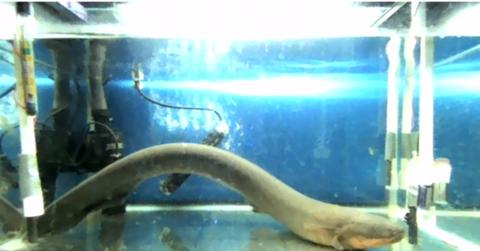Shocking Discovery: Electric Eels Responsible for Genetic Modifications on Aquatic Life

Researchers say the zaps released by electric eels have the ability to genetically modify small fish larvae.
Dec. 12 2023, Published 9:04 a.m. ET
A new study has unveiled a surprising aspect of electric eels, suggesting that their electrical discharges can induce genetic modifications in neighboring animals.
Researchers from Nagoya University in Japan revealed that electric eels possess the capability to release sufficient electricity to genetically alter small fish larvae, according to the findings recently published in the journal PeerJ Life and Environment.
According to the study, electric eels can discharge up to 860 volts, establishing them as the largest electricity-producing creatures on the planet. This immense electrical power can even be harnessed to operate machinery.
Atsuo Iida, an assistant professor in biotechnology at Nagoya University and co-author of the study, explained that electric eels have a specialized tissue called the "electric organ" responsible for generating high-voltage discharges, Newsweek reported.
The research focused on the application of electroporation, a gene delivery technique involving the creation of temporary pores in cell membranes, which allows molecules like DNA or proteins to get in.
Researchers suspected that electroporation might occur in natural settings beyond laboratory conditions. Iida expressed his initial thoughts, stating, "I thought electroporation might happen in nature,” according to Nagoya University.
- What Lies Beneath: NASA Scientist Believes Aliens May Have Found 'Perfect' Hiding Spot in Earth's Oceans
- Global Threat: Russia Insider Warns West of 'World War Using Nuclear Weapons' Amid Escalating Support for Ukraine
- Countdown to Disaster? Ex-NATO Official Warns Russia, Iran and China Could Wage WWIII in Just Years
With the awareness that cells can integrate DNA fragments from water, known as environmental DNA, the researchers hypothesized that electricity could modify the cells of nearby organisms in natural water bodies.
Iida said, "I realized that electric eels in the Amazon River could well act as a power source, organisms living in the surrounding area could act as recipient cells, and environmental DNA fragments released into the water would become foreign genes, causing genetic recombination in the surrounding organisms because of electric discharge."
Never miss a story — sign up for the Front Page Detectives newsletter. Be on the scene the moment news breaks.
To test this hypothesis, scientists exposed young zebrafish to a DNA solution, which would glow brightly if the new DNA was absorbed by the animal. Then an electric eel was introduced into the environment, triggering it to release an electrical discharge. The study revealed that 5% of the fish larvae exhibited evidence of gene transfer.
Iida emphasized that these findings could open the door to further studies in electric field research in living organisms. He acknowledged that the impacts of electricity on Earth's creatures may surpass conventional understanding.
The study underscores the potential role of electric eels and other electricity-generating organisms in influencing genetic modifications in nature.
Become a Front Page Detective
Sign up to receive breaking
Front Page Detectives
news and exclusive investigations.
